College of Charleston
The College of Charleston (CofC or Charleston) is a public university in Charleston, South Carolina. Founded in 1770 and chartered in 1785, it is the oldest university in South Carolina, the thirteenth oldest institution of higher learning in the United States, and the oldest municipal college in the country. The founders of the institution included three future signers of the Declaration of Independence (Thomas Heyward Jr., Arthur Middleton, and Edward Rutledge), and three future signers of the United States Constitution (Charles Pinckney, Charles Cotesworth Pinckney, and John Rutledge).
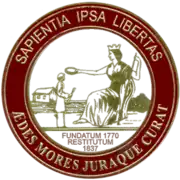 | |
| Motto | Sapientia Ipsa Libertas (Latin) Ædes Mores Juraque Curat (Latin) |
|---|---|
Motto in English | "Wisdom Itself Is Liberty" "She Cares for Her Temples, Customs and Rights" |
| Type | Public university |
| Established | 1770 |
| Accreditation | SACS |
Academic affiliations | |
| Endowment | $135.9 million (2021)[1] |
| President | Andrew Hsu |
Administrative staff | 836 |
| Undergraduates | 9,972 |
| Postgraduates | 913 |
| Location | , , United States |
| Campus | Midsize city[2], 80 acres (0.32 km2) |
| Newspaper | The College Today |
| Colors | Maroon and white [3] |
| Nickname | Cougars |
Sporting affiliations | |
| Mascot | Cougar |
| Website | cofc |
 | |
College of Charleston | |
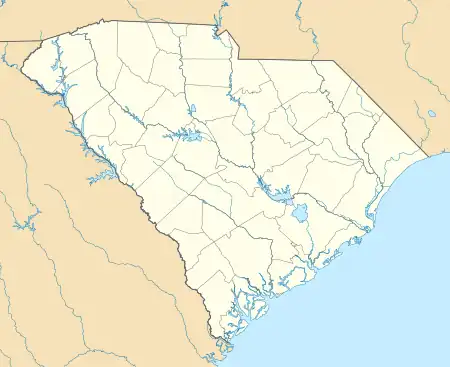  | |
| Location | Glebe, George, St. Philip and Green streets, Charleston, South Carolina |
| Area | 4 acres (1.6 ha)[4] |
| Built | 1827 |
| Architect | Edward B. White; George E. Walker |
| Architectural style | Early Republic |
| NRHP reference No. | 71000748 |
| Significant dates | |
| Added to NRHP | November 11, 1971[5] |
| Designated NHL | November 11, 1971[6] |
History
The College of Charleston was founded in 1770, making it the thirteenth oldest institution of higher education and oldest municipal college in the United States.[7][8] The college's original structure, located at the site of what is now Randolph Hall, was designed similar to a barracks. In March 1785, the South Carolina General Assembly issued a charter to the college, which officially opened in 1790 and hosted its first commencement in 1794. The first president of the college was Robert Smith, who served in the position from 1790 to 1797. A second charter was issued by the general assembly in 1791 stipulating that the college would not discriminate on the basis of religion. During the Antebellum era, further development efforts in the college resulted in the construction of Randolph Hall and the President's House, both of which were built using slave labor. In 1837, the Charleston municipal government assumed control over the college. During the mid-20th century, several African Americans attempted to apply to the racially segregated college as part of the Double V campaign against racism in the United States, but they were all rejected. Though the college became a private institution to avoid being racially integrated during the civil rights movement, black students were admitted starting in 1967 as a result of external pressure.[9][10]
Academics
| Academic rankings | |
|---|---|
| Regional | |
| U.S. News & World Report[11] | 8 |
| Master's university | |
| Washington Monthly[12] | 302 |
| National | |
| Forbes[13] | 323 |
| THE / WSJ[14] | 501–600 |
The College of Charleston consists of seven academic schools, as well as the Honors College and the Graduate School.
- The School of the Arts
- The School of Business
- The School of Education
- The School of Health Sciences
- The School of Humanities and Social Sciences
- The School of Languages, Cultures, and World Affairs
- The School of Sciences, Mathematics, and Engineering
- The Honors College
- The Graduate School
Campus
The College of Charleston's main campus in downtown Charleston includes 156 buildings, a mix of modern and historic buildings constructed from 1770 to 2009. The average building is more than 100 years old. Twenty buildings are under historic, protective easements. The College of Charleston downtown campus is listed on the National Register of Historic Places.
Outside of downtown Charleston, the campus includes the Grice Marine Lab on James Island, the J. Stewart Walker Sailing Center and the Patriots Point Athletic Complex in Mount Pleasant and the 881-acre (357 ha) Stono Preserve.[15]
In 2017, Travel + Leisure magazine named it "America's Most Beautiful College Campus."[16]
The Mace Brown Museum of Natural History is a public natural history museum located on the campus. The museum has more than 30,000 vertebrate and invertebrate fossils. The collection's focus is on the paleontology of North American mammals, and specifically the South Carolina Lowcountry.[17]
Bully Pulpit Series
The Bully Pulpit Series is hosted jointly by the College of Charleston's Departments of Political Science and Communication. The series welcomes presidential candidates from the two major political parties to the campus. Candidates speak with students and Charleston community members on such topics as the frequency of press conferences, the candidate's relationship with journalists and the power of the president to persuade. Major candidates that appeared during the 2008 Presidential primaries included Senator John McCain, Congressman Ron Paul, President Barack Obama and Senator John Edwards. During that season, the series was sponsored by the Allstate Insurance Company and attendance on the Bully Pulpit events drew over 6,000 attendees.[18] During the 2016 Presidential primaries, the major candidates who participated in the series included Senator Lindsey Graham and former Maryland governor Martin O'Malley. The series hosted a slew of candidates during the 2020 Democratic Party presidential primaries. The candidates who appeared were: Mayor Pete Buttigieg, Representative Beto O'Rourke, Secretary Julian Castro, Senator Amy Klobuchar, Senator Bernie Sanders, former vice president and eventual president Joe Biden, and Representative Tulsi Gabbard.[19]
Athletics
The institution's 19 varsity sports teams participate in the NCAA Division I Colonial Athletic Association and are known as the Cougars. The Cougars compete at a variety of athletics facilities in the Charleston area, including the TD Arena (formerly the Carolina First Arena),[20] the J. Stewart Walker Sailing Complex, Johnson Center Squash Courts, Patriots Point Athletic Complex and the Links at Stono Ferry. College of Charleston athletics are supported by the College of Charleston Athletic Club,[21] which was established in 1974. During the 1970–71 school year, College of Charleston students voted to change the nickname from the Maroons to the Cougars, in honor of a cougar that had recently arrived at the Charles Towne Landing zoo. Clyde the Cougar is the current mascot.[22] Oliver Marmol, the new manager of the St. Louis Cardinals is a former College of Charleston baseball player.
Greek life
Greek life has been active on campus for 120 years. In 2017, four fraternities were shut down by the college for alcohol, drugs and a sexual assault.[23]
Notable alumni
Buildings
Listed on the Register of Historic Places
- Randolph Hall, the college's main academic building
- William Blacklock House
Historic buildings
 Randolph Hall
Randolph Hall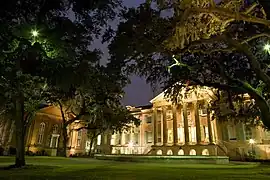 Randolph Hall
Randolph Hall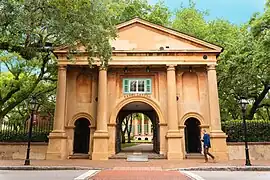 Porter's Lodge
Porter's Lodge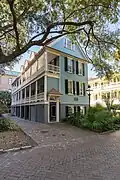 Communication Building
Communication Building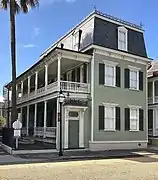 92 Wentworth, an historic student residence
92 Wentworth, an historic student residence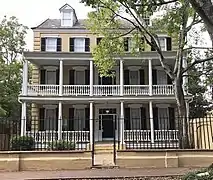 Benjamin Lucas House, 24 Bull Street, built circa 1858
Benjamin Lucas House, 24 Bull Street, built circa 1858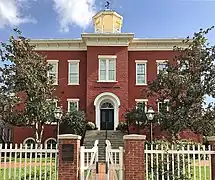 Avery Research Center
Avery Research Center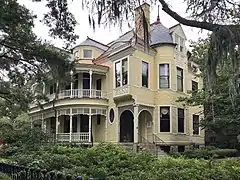 Sottile House
Sottile House
Other buildings
 Marion and Wayland H. Cato Jr. Center for the Arts
Marion and Wayland H. Cato Jr. Center for the Arts Sylvia Vlosky Yaschik Jewish Studies Center
Sylvia Vlosky Yaschik Jewish Studies Center Liberty Street Residence Hall
Liberty Street Residence Hall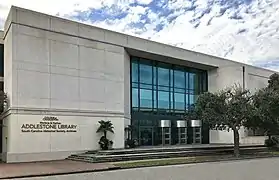 Marlene and Nathan Addlestone Library
Marlene and Nathan Addlestone Library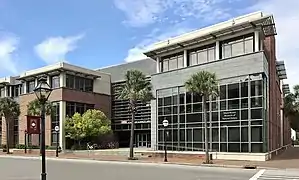 School of Sciences, Math, and Engineering
School of Sciences, Math, and Engineering Patriots Point Athletic Complex
Patriots Point Athletic Complex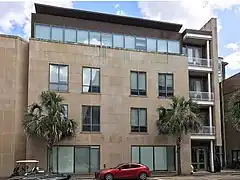 Beatty Center
Beatty Center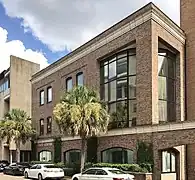 Tate Center for Entrepreneurship
Tate Center for Entrepreneurship.jpg.webp) Rita Hollings Science Center
Rita Hollings Science Center Robert Scott Small Building
Robert Scott Small Building
References
- College of Charleston Foundation 2021 (Report).
- "IPEDS-College of Charleston".
- "Color Palette - College of Charleston". Archived from the original on March 13, 2018. Retrieved March 13, 2018.
- Staff, National Survey of Historic Sites and Buildings (August 1971). "National Register of Historic Places Inventory-Nomination: College of Charleston Complex: Main Building, Library and Gate Lodge" (PDF). National Park Service. Retrieved June 22, 2009.
{{cite journal}}: Cite journal requires|journal=(help) and Accompanying four photos, exterior and interior, from 1970 (1.43 MB) - "National Register Information System". National Register of Historic Places. National Park Service. January 23, 2007.
- "College of Charleston". National Historic Landmark summary listing. National Park Service. Archived from the original on October 23, 2007. Retrieved March 19, 2008.
- "A Brief History of the College - College of Charleston". www.cofc.edu. Retrieved August 16, 2017.
- Municipal college; Easterby, J.H. (1935)"Appendix I: Charters and Other Documents in A History of the College of Charleston, pp. 252. USA: The Scribner Press
- Ileana Strauch and Katina Strauch,The College History Series - College of Charleston(Arcadia Publishing:Library of Congress Catalog Card: 00-106473) 2000 p6.
- Hansen, Victoria (February 6, 2020). "College of Charleston Acknowledges its Past with the Center for the Study of Slavery". South Carolina Public Radio. Retrieved January 14, 2023.
- "Best Colleges 2023: Regional Universities Rankings". U.S. News & World Report. Retrieved September 25, 2023.
- "2020 Rankings -- Masters Universities". Washington Monthly. Retrieved August 31, 2020.
- "Forbes America's Top Colleges List 2023". Forbes. Retrieved September 22, 2023.
- "Wall Street Journal/Times Higher Education College Rankings 2022". The Wall Street Journal/Times Higher Education. Retrieved July 26, 2022.
- Behre, Robert. "Nixing Dixie: College of Charleston renames its plantation 'Stono Preserve'". Post and Courier. Retrieved October 25, 2019.
- "College of Charleston, America's Most Beautiful College Campus, in Photos | Travel + Leisure".
- "Digging into the Past". Azalea Summer 2015. June 1, 2015. Retrieved June 24, 2021.
- The Bully Pulpit Series at the College of Charleston Archived 2008-12-04 at the Wayback Machine
- "The Bully Pulpit Series at the College of Charleston". Archived from the original on April 6, 2020. Retrieved July 25, 2020.
- Whetzel, Melissa (August 23, 2011). "College, TD Bank Sign Naming Agreement for Arena - College of Charleston News : College of Charleston News". News.cofc.edu. Archived from the original on December 3, 2013. Retrieved August 15, 2014.
- "College of Charleston Athletic Fund". www.cofcathleticfund.com. Retrieved January 4, 2022.
- "College of Charleston To Join Colonial Athletic Association, 11/30/2012". Archived from the original on December 3, 2013. Retrieved January 14, 2013.
- Pan, Deanna (July 2, 2017). "A fourth College of Charleston fraternity has shut down due to misconduct". Post and Courier. Retrieved July 31, 2020.